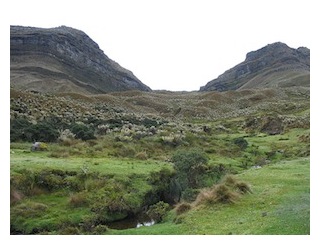
A Dictionary of the Fuchsia™
Want to know what those mysterious terms mean and just who the people were behind those names? Then this is the place for you.
Want to know what those mysterious terms mean and just who the people were behind those names? Then this is the place for you.
Pachyrrhiza – Having thick roots, thick footed. See F. pachyrrhiza in ➤ Section Pachyrrhiza. (Note: The term is often spelled as pachyrhiza by botanists. F. pachyrrhiza, however, should always correctly retain its double Rs as that was how it was originally described and published by Berry & Stein in 1988.)
Pallescens – Palid or pale; becoming palid or pale. See F. pallescens in ➤ Section Fuchsia.
Palo Blanco – Common name occasionally recorded in Chile for F. magellanica. Chilco, however, is more usual.
Palo de Yegua – Common name in Chile for F. lycioides. Also sometimes called palo falso. However, the name Palo de yegua is also applied to another unrelated Chilean native, Senecio yegua (Acrisione denticulata), the palpalén.
Palynology – The study of dust and other minute particles. The discipline includes the study of both modern and fossilized grains of Fuchsia pollen. See ➤ Diporites aspis.
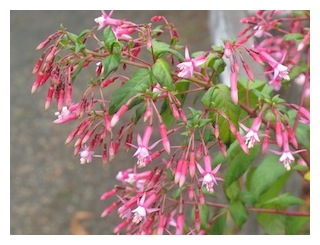 Paniculates – The relatively small individual blossoms of the two species in the Schufia section are carried in terminal clusters, looking similar to lilacs, called panicles. As recent breeders are increasingly incorporating F. arborescens or F. paniculata into their crosses, the resulting plants with similarly branched inflorescences are often termed paniculates. Examples of this group include such fairly recent cultivars as 'Miep Aalhuizen' 'Lechlade Gorgon' and 'First Success.'
Paniculates – The relatively small individual blossoms of the two species in the Schufia section are carried in terminal clusters, looking similar to lilacs, called panicles. As recent breeders are increasingly incorporating F. arborescens or F. paniculata into their crosses, the resulting plants with similarly branched inflorescences are often termed paniculates. Examples of this group include such fairly recent cultivars as 'Miep Aalhuizen' 'Lechlade Gorgon' and 'First Success.'
(Illustration: Fuchsia 'First Success'.)
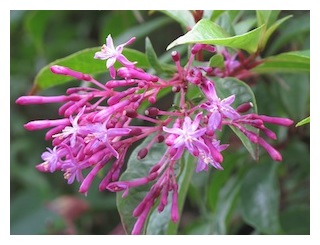 Panicle – A lilac-like, loosely branched flowering unit that consists of a number of clusters or racemes of smaller individual blossoms. Panicles in fuchsias might often contain both flowers and berries as newer blossoms continue opening towards the tip and older ones at the base have gone to fruit.
Panicle – A lilac-like, loosely branched flowering unit that consists of a number of clusters or racemes of smaller individual blossoms. Panicles in fuchsias might often contain both flowers and berries as newer blossoms continue opening towards the tip and older ones at the base have gone to fruit.
(Illustration: A blossoming panicle on F. paniculata; See also the illustration under ➤ Berries for the same species in full fruit.)
Paniculata – Flowers held in panicles. See F. paniculata in ➤ Section Schufia of which there are two subspecies. Because both bear flowers in similar lilac-like panicles, F. paniculata is often confused with its close relative, F. arborescens. However, it generally forms a smaller shrub growing only roughly to half the size of the later. Its more variably shaped leaves are also generally smaller, with a ridged surface and distinctively minutely to coarsely serrated margins. F. arborescens, on the other hand, generally forms a larger shrub or small tree with smoother and more consistently shaped, oblanceolate leaves that have an entire margin. There are also other tell-tale differences in the flowers as well. The unopened buds of F. paniculata, for example, are comparatively more long and narrow than those of F. arborescens, which are broader and more blunted towards the tip. See also Arborescens.
Páramo – A variety of similar neotropical alpine ecosystems found above the continuous forest line but below the permanent snow line and characterized by a vegetation dominated by grasses, shrubs and giant rosette-forming plants. While some scientists use the term broadly, páramo most particularly refers to those high altitude ecosystems located in the northern Andes of South America, specifically in Venezuela, Colombia, Ecuador and Peru, and some adjacent areas of southern Central America. The classification can be further broken down into the superpáramo and subpáramo.
The superpáramo generally occurs between 4,500 to 4,800 meters in altitude and is a transitional zone with the lowest temperatures, precipitation and poorest soils.
The subpáramo is a lower and more diverse transitional zone. It generally occurs between 3,000 to 3,500 meters in altitude and combines the characteristics of both the grass-dominated páramo above and the forest below, containing small, scattered trees, or even pockets of forest in sheltered microclimates.
See also Campos de Altitude.
(Illustration: Páramo in the Sumapaz National Park in Colombia, photo by ➤ Yuri Romero Picon, Wikipedia, 2008.)
Parviflora – Having small flowers. F. parviflora (Lindl.1827) is an accepted species. F. cylindracea (Lindl. 1838) is a synonym of this species while F. parviflora (Zucc. 1837) is a synonym of F. encliandra subsp. encliandra (Steudel 1840).
 Pavón, José Antonio (1754-1840) – José Antonio Pavón y Jiménez was a Spanish pharmacologist and botanist perhaps best know for his participation in the Botanicial Expedition to the Viceroyalty of Peru that took place between 1779 and 1788.
Pavón, José Antonio (1754-1840) – José Antonio Pavón y Jiménez was a Spanish pharmacologist and botanist perhaps best know for his participation in the Botanicial Expedition to the Viceroyalty of Peru that took place between 1779 and 1788.
Pavón, along with the French physician and botanist Joseph Dombey (until 1784), had been selected to assist Hipólito Ruiz on this major scientific exploration of Spanish possessions in the Americas commissioned by the reformist Spanish king, Charles III.
The expedition was a major success and returned to the Royal Botanical Garden in Madrid in 1788 with more than ten thousand engravings, 2,254 botanical drawings with descriptions and numerous other materials. Ruiz, along with Pavón, would publish the results in a number of volumes.
A member of the Royal Academy of Medicine in Madrid, Pavón would also be inducted into the Linnaean Society in London in 1820.
See also ➤ Ruiz; Ruiz & Pavón; ➤ Royal Botanicial Expedition to the Viceroyalty of Peru.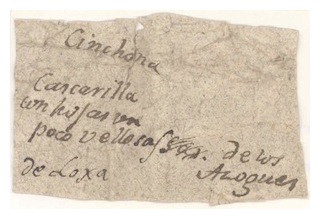
(Illustrations: 1. Cinchona hirsuta (Ruiz & Pavon 1799), Flora Peruviana, et Chilensis, Plates 153-325, Vol. 2, Tab. 192 (1798-1802). Of intense interest in Europe at the time was the pharmacology of New World plants, especially important ones such as Cinchona, the source of the invaluable anti-malarial drug, quinine; 2. Autograph label from a specimen collection of Cinchona apparently made by Pavón at "los Azogues de Loxa" (Loja; Azogues is today in Ecuador's Cañar Province) during the expedition.)
Pedicel – The stalk of individual flower; a stalk bearing a single flower within a cluster (see also ➤ Peduncle).
Peduncle – The axis of an inflorescence; the stalk supporting an inflorescence; the short stalk at the base of a leaf or reproductive structure (see also pedicle).
Pelargoniums – See Geraniums.
Pendientes de la Reina – Common name for the fuchsia in some Spanish-speaking areas. Literally "Queen's Eardrops." There is often an association with the Virgin Mary, as the Queen of Heaven, and the form, Pendientes de la Virgen, is sometimes found. See also ➤ Aljaba, ➤ Chilco, ➤ Corales, ➤ Coralitos.
Pendula – Pendant, hanging. F. pendula (Salisb. 1796) is a synonym of F. coccinea in ➤ Section Fuchsia.
Penduliflora – With pendant or hanging flowers. F. x peduliflora (Hook.f 1877) is an unresolved name.
Pendulina – Pendulous, hanging. F. x pendulina (Veitch 1856) is an unresolved name.
Perbrevis – Very small or little. F. perbrevis (I.M.Johnston 1925) is a synonym of F. verrucosa ➤ Section Verrucosa.
Perfect Flowers – Bisexual flowers on which both the male and female reproductive parts are contained within the same flower. See also ➤ Breeding Systems.
Perianth – The outermost part of a flower consisting of the calyx and corolla together.
Perscandens – Scrambling. See F. perscandens in ➤ Section Skinnera.
Personal Names – See ➤ Fuchsia (personal name).
Pests & Diseases – See ➤ Aphids, ➤ Caspid Bug, ➤ Fuchsia Gall Mite, ➤ Fuchsia Rust, ➤ Red Spider Mite, ➤ Vine Weevil, ➤ Whitefly.
Petal – A single part of the corolla. Fuchsia blossoms naturally have four petals in the corolla. (See also ➤ Double, ➤ Semi-double, ➤ Single.)
Petaloid – Smaller outer petals of the corolla.
Petiolaris – Having a remarkable leaf stalk. See F. petiolaris in ➤ Section Fuchsia.
Petiole – The leaf stalk.
Phenotype – The appearance of a plant as influenced by the environment on its genotype, or inherited genetic code. In its simplest terms, there is often a distinct difference in flower and leaf color and size, for example, when the same fuchsia hybrid is grown in a bright or sunny exposure as opposed to a more shady one. Another example might be species that are naturally liana-like or vine-like, such a Fuchsia regia, when scrambling through, over, or into brush and trees, but will grow more compact, upright and shrub-like when exposed.
Photosynthesis – The chemical process by which plants convert carbon dioxide and water into stored energy in the form of sugar molecules using energy from sunlight. Oxygen molecules are released as a by-product. This process take place primarily in ➤ chloroplasts, located in a plant's leaves, using chlorphyll (see also).
Phylogenetics – In Botany, the study of evolutionary relationships among groups of plants.
Pilaloensis – From Pilaló in Cotopaxi Province in Ecuador. See F. pilaloensis in ➤ Section Hemsleyella.
Pilosa – Covered in soft, fine hairs. See F. pilosa in ➤ Section Fuchsia.
Pilose – Covered with soft, fine hairs. Some fuchsias, such as F. alpestris or F. bracelinae, have leaves and stems that can be very densely pilose especially in young growth. Since the more pilose fuchsia species have not been commonly used for crosses, this trait is not usually seen in any garden cultivars.
Pinching – Also called stopping. The removal of the growing tip of a branch. Pinching or stopping will encourage side buds to break from the leaf axils and result in a bushier, more floriferous plant. A plant will often be pinched or stopped several times before it's left to flower for the season.
Pistil – The female division of the flower which consists of the ovary, stigma and style.
Pistillate Flowers – Female flowers in which the male reproductive parts are absent or reduced to sterility. See also ➤ Breeding Systems.
Pitz'otz' – Fuchsia encliandra subsp. tetradactyla and Fuchsia thymifolia subsp. minimiflora in Tzotzil, a language of the Maya in the state of Chiapas, Mexico. The name is also extended to Cuphea cyanea, Ludwigia octovalvis and Monnica xalapensis. See ➤ Maya.
Plant Geography– The spatial distribution of plants and vegetation in different environment and regions. Also termed phytogeography, phytochorology, geobotany, geographical botany, or vegetation science.
The Plant List – An on-line project undertaken by the Royal Botanic Gardens, Kew and the Missouri Botanical Garden, St. Louis, with other collaborators worldwide, that combines several institutional checklists to create a working list of all known plant species.
The first Version 1.0 released in December 2010 aimed to be comprehensive for species of Vascular plant (flowering plants, conifers, ferns and their allies) and for Bryophytes (mosses and liverworts). while it does not currently include algae or fungi, Version 1.1 (September 2013) does have 1,293,685 million scientific plant names. 350, 699 are accepted species names and the rest are synonyms. No vernacular or common plant names are included.
You can find most all current accepted and synonymous species within Fuchsia at ➤ The Fuchsia Plant List. However, as with any undertaking of this amazing immensity, omissions can creep in and about 23% of the names in the full list are still unresolved. Fuchsia paniculata subsp. paniculata, for example, is listed as a synonym as of this writing in Version 1.1. That’s incorrect. Fuchsia paniculata subsp. mixenesis is also missing. Both have been validly described since 1998.
Frustratingly in this Age of Information, the Plant List’s data waits for system wide version updates rather than faster more immediate data set corrections. Inaccuracies linger years longer than they should.
Plant Patent – The abbreviation PPAF (Plant Patent applied For) will sometimes be seen on commercially raised plants in the United States and indicates an application for a plant patent from the U.S. Patent and Trademark Office that "precludes others from asexually reproducing or selling or using the patented plant. A plant patent expires 20 years from the filing date of the patent application." Plants for which patents have already been granted will have a patent number in the format "PP# 00,000" on the label. Plants become public domain when the patent expires.
Platypetala – Broad-petalled. F. platypetala (I.M Johnston 1939) is an unresolved name.
 Plumier, Charles (1646–1704) – Father Charles Plumier was the Minim monk and French botanist generally credited with the discovery and description of the first fuchsia.
Plumier, Charles (1646–1704) – Father Charles Plumier was the Minim monk and French botanist generally credited with the discovery and description of the first fuchsia.
Almost nothing is known about Plumier's family and early life except that he was born in Marseille and entered the religious order of the Minims there at the age of sixteen. He devoted himself to scientific studies with the Minims, studied botany for a period in Italy, and eventually returned to France to became a pupil of Joseph Pitton de Tournefort (1656-1708), the noted botanist and professor at the Jardin du Roi in Paris, whom he accompanied on botanical explorations. Plumier's botanical connections, and his meticulous collections and observations along the coasts of Provence and the Languedoc, of course brought him to the attention of fellow scientists, as well as the royal government in Paris.
 In 1689, he was asked by Joseph Donat Surian (d. 1691; see also), a pharmacist and physician also from Marseille, to accompany him as his illustrator and writer on an official government mission to the French Antilles. Despite tense relations between the cantankerous Surian and Plumier, the pair remained in the Caribbean for a year and a half and the publication of the journey, Description des Plantes d'Amérique in 1693, resulted in Plumier's appointment as Royal Botanist.
In 1689, he was asked by Joseph Donat Surian (d. 1691; see also), a pharmacist and physician also from Marseille, to accompany him as his illustrator and writer on an official government mission to the French Antilles. Despite tense relations between the cantankerous Surian and Plumier, the pair remained in the Caribbean for a year and a half and the publication of the journey, Description des Plantes d'Amérique in 1693, resulted in Plumier's appointment as Royal Botanist.
Plumier was then sent back to the Antilles on a second journey in 1693, and on yet a third in 1695, assisted there by the Dominican botanist and missionary Jean-Baptiste Labat (1663-1738). The materials he gathered were prodigious and only partially released in his Nova Plantarum Americanum Genera (Paris, 1703). It was in this work, though, that Plumier first described Fuchsia triphylla, flore coccineo, found growing on Hispaniola during the course of the third expedition in about 1696–97. He baptized the new genus in honor of the celebrated German physician and botanist, Leonhart Fuchs (see also).
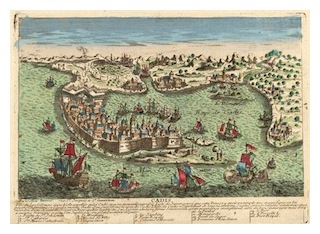 With his next publication on the plants of the French Antilles awaiting release in 1704 as the Traité des Fougères de l'Amérique (Paris, 1705), Plumier was asked by the French government to undertake a fourth exploratory trip, this time to Peru to investigate the true Cinchona tree, the bark of which was the source of the important anti-malarial drug, quinine. Unfortunately, he died of pleurisy that same year at the Minim Monastery of Our Lady of Victory, in Puerto de Santa Maria near Cadíz, where he was living while waiting to embark on the first leg of the trip.
With his next publication on the plants of the French Antilles awaiting release in 1704 as the Traité des Fougères de l'Amérique (Paris, 1705), Plumier was asked by the French government to undertake a fourth exploratory trip, this time to Peru to investigate the true Cinchona tree, the bark of which was the source of the important anti-malarial drug, quinine. Unfortunately, he died of pleurisy that same year at the Minim Monastery of Our Lady of Victory, in Puerto de Santa Maria near Cadíz, where he was living while waiting to embark on the first leg of the trip.
It's interesting to think what such an accomplished and meticulous botanist as Plumier might have discovered in Peru, earlier rather than later, had he lived to make the journey. The Monastery of the Victory was secularized in in the eighteenth century and the once-beautiful complex was much reduced and damaged, especially as it was used as a prison from 1886 until 1981. Today it's partially restored and preserved as an historic Bien de Interés Cultural and the celebrated royal botanist's body presumably still lies somewhere within the monastery's former perimeter, buried in a grave unmarked and forgotten.
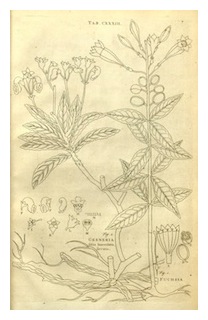 At his death Plumier left mountains of unpublished materials behind in Paris. In the French National Library, there are today thirty-one manuscript volumes containing his notes and descriptions. Additionally, there are about six thousand of his drawings, four thousand of which are plants, while the remainder illustrate American animals, especially birds and fishes.
At his death Plumier left mountains of unpublished materials behind in Paris. In the French National Library, there are today thirty-one manuscript volumes containing his notes and descriptions. Additionally, there are about six thousand of his drawings, four thousand of which are plants, while the remainder illustrate American animals, especially birds and fishes.
Herman Boerhaave (1668–1738), a celebrated professor of botany and medicine at the University of Leiden in the Netherlands, had 508 of Plumier's drawings copied for him. They were later published in Plumier's honor by Johannes Burman (1707–1780), an professor of botany in Amsterdam who had studied under Boerhaave and even employed a young Carl Linnaeus (1707–1778) to complete a flora of Ceylon for him during his stay there in 1735, as the Plantarum americanarum, quas olim Carolus Plumerius botanicorum princeps detexit in 1755–1760. Linnaeus would use the drawings in this volume to accept Plumier's Fuchsia triphylla into the sixth edition of his Genera Plantarum.
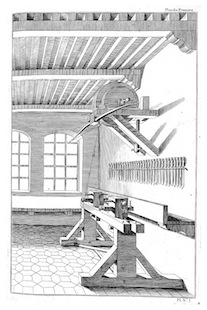 Plumier also wrote scientific treatises for the Journal des Savants and for the Mémoires de Trévoux. An especially interesting article comes from his observations in Martinique to prove that the cochineal belongs among insects in the animal kingdom. Perhaps Plumier's most interesting work, though, is of an entirely different character and considerably outside the fields of science and botany. Plumier wrote and skillfully illustrated, L'Art de tourner, a volume of practice and instruction for turning wood on a lathe in 1701. This authoritative publication on what was apparently his hobby was widely disseminated–translated into Russian even by Peter the Great himself in St. Petersburg–and would remain the definitive work on the subject until well into the nineteenth century. It's such an odd, yet very accomplished, area of expertise that it's been suggested he was apprenticed and trained in wood turning in his early years in a workshop. Plumier's unknown father might have been a cabinet maker.
Plumier also wrote scientific treatises for the Journal des Savants and for the Mémoires de Trévoux. An especially interesting article comes from his observations in Martinique to prove that the cochineal belongs among insects in the animal kingdom. Perhaps Plumier's most interesting work, though, is of an entirely different character and considerably outside the fields of science and botany. Plumier wrote and skillfully illustrated, L'Art de tourner, a volume of practice and instruction for turning wood on a lathe in 1701. This authoritative publication on what was apparently his hobby was widely disseminated–translated into Russian even by Peter the Great himself in St. Petersburg–and would remain the definitive work on the subject until well into the nineteenth century. It's such an odd, yet very accomplished, area of expertise that it's been suggested he was apprenticed and trained in wood turning in his early years in a workshop. Plumier's unknown father might have been a cabinet maker.
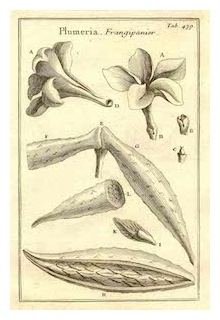
While he honored a number of people in the names of many now well-known genera, such the Begonia, Bromelia, Fuchsia, Gesnera, Lobelia, Lonicera, Magnolia and Pittonia—even a Suriana—Plumier rightfully and modestly never named one of his discoveries for himself. Joseph Pitton de Tournefort, the recipient of Pittonia and his former teacher and fellow botanist, would see to that honor with the Plumeria, the frangipani as it's also commonly known, in 1700. Plumeria was later accepted by Linneus in 1753.
(Illustrations: 1. Portrait of Plumier (Nova Plantarum, 1704); 2. F. triphylla illustrated on Plate 14 in Nova Plantarum. 3. View across Cadiz's harbor towards the Puerto de Santa María where Plumier died in 1704 (Basset, Paris, 1700); 4. Plate of Fuchsia from Burman's Plantarum americanarum, quas olim Carolus Plumerius botanicorum princeps detexit in (1755–1760). It shares the page with Gesneria; 5. Plate from Plumier’s L’Art de Tourner, ou de Faire en Perfection toutes Sortes d'Ouvrages au Tour, 1706; 6. Plumeria, named by Joseph Pitton de Tournefort to honor Plumier. Institutiones rei herbariæ, vol. 3: t. 439, 1700.)
Pollen – The powdery substance produced in the fuchsia's anthers. Pollen contains the male reproductive cells, male gametes or sperm cells. Fertilization results when pollen cells are carried to the stigmas of other flowers by wind or insects, or by the intentional hand of the hybridizer, and germinate to transfer the sperm to the ovule via a pollen tube. Pollen of the Onagraceae family, of which Fuchsia is a member, is easily differentiated from that of most other angiosperm families under the microscope by tetrads and the presence of sticky viscin threads that makes it conspicuously clumped. (See Tetrads, Viscine Threads)
Pollen Fossils – In palynology, the study of dust and other minute particles including spores and pollen, taxonomic distinctions are usually kept between fossil and modern pollen forms unless there is ample scientific evidence to support a connection between the two. Fossil pollen similar to that of modern Fuchsia, for example, was originally described as Diporites aspis Pocknal & Mildenhall. More fossil pollen discoveries were closely examined. A study done in 1985, compared them with similar modern forms and revealed that Diporities aspis and Fuchsia were the same. Later, an unique fossil Fuchsia flower and an associated anther mass with in situ pollen from the early Miocene were discovered in a quarry in New Zealand, unequivocally showing that Diportites apsis belongs to the genus Fuchsia. An identification blow the genus level, however, remains impossible to make. The replacement name for Diporites aspis is Koninidites aspis (Pocknall & Mildenh.) See Fuchsia antiqua.
Pollenizer – The plant that is a source of pollen in the pollination process. In stating the parentage of crosses, such as F. magellanica 'Molinae' x F. excorticata for 'Whiteknight's Amethyst', the plant listed first is the female parent followed secondly by the pollenizer. The term shouldn't be confused with a pollinator (see also).
(Illustration: A bee pollinates Fuchsia magellanica in the Patagonian Lake District, Argentina.)
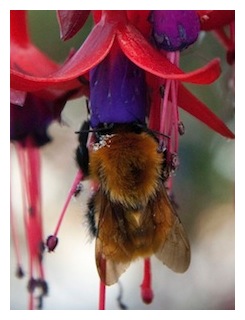 Pollinator – Any agent that moves pollen from the male anthers of a flower to the female stigma of a flower to accomplish fertilization (syngamy) of the female gamete in the ovule by the male gamete in the pollen grain. In fuchsias, hummingbirds are the pollinators most closely associated with the genus in their native habitats and the flowers seem specifically evolved to attract these birds. Bees, however, are as prolific pollinators of fuchsias as they are of most other flowers, even in the plants' native habitats. (Illustration: A bee visiting F. magellanica blossoms in Patagonia.)
Pollinator – Any agent that moves pollen from the male anthers of a flower to the female stigma of a flower to accomplish fertilization (syngamy) of the female gamete in the ovule by the male gamete in the pollen grain. In fuchsias, hummingbirds are the pollinators most closely associated with the genus in their native habitats and the flowers seem specifically evolved to attract these birds. Bees, however, are as prolific pollinators of fuchsias as they are of most other flowers, even in the plants' native habitats. (Illustration: A bee visiting F. magellanica blossoms in Patagonia.)
Pollinization – The process by which pollen is transferred from the anthers to the surface of the stigma enabling fertilization and sexual reproduction in plants
Polyantha – Having many flowers. See F. polyantha (Killip ex Munz 1943) in ➤ Section Fuchsia.
Polyanthella – F. polyanthella (I.M. Johnston 1925) is a synonym of F. ovalis in ➤ Section Fuchsia.
Polyploid, Polyploidy – Having multiple sets of chromosomes.
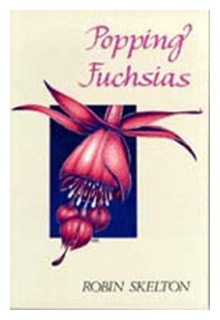 Popping Fuchsias – Popping Fuchsias: Poems, 1987-1992 (1992) is a book of poems by the British-born academic and poet, Robin Skelton (1925-1997). In 1963, Skelton began teaching at the University of Victoria in British Columbia. An authority on Irish literature, he was also well known for his work as a literary editor (he was a co-founder and editor of The Malahat Review) and translator. Known as a practicing Wiccan, he published a number of books on the subject of the occult and neopagan religions. Skelton was born in Eaasington, Yorkshire and ➤ Popping Fuchias, the poem that gives its title to the collection, begins, "Beside the front steps, of my boyhood schoolhouse, bloomed a fuchsia, rich with fascination…" ➤ Popping Fuchsias.
Popping Fuchsias – Popping Fuchsias: Poems, 1987-1992 (1992) is a book of poems by the British-born academic and poet, Robin Skelton (1925-1997). In 1963, Skelton began teaching at the University of Victoria in British Columbia. An authority on Irish literature, he was also well known for his work as a literary editor (he was a co-founder and editor of The Malahat Review) and translator. Known as a practicing Wiccan, he published a number of books on the subject of the occult and neopagan religions. Skelton was born in Eaasington, Yorkshire and ➤ Popping Fuchias, the poem that gives its title to the collection, begins, "Beside the front steps, of my boyhood schoolhouse, bloomed a fuchsia, rich with fascination…" ➤ Popping Fuchsias.
Porcher, Pierre-Félix (1797-1878) – Félix Porcher was president and co-founder of the Société d'Horticulture d'Orléans in France. His article on fuchsias, which had first appeared in the Society's Bulletin, was published as the first book on Fuchsias, Le Fuchsia, son histoire et sa culture, in 1844 and listed three hundred fuchsias. A second edition, released in 1848, was substantially expanded to list well over five hundred. Porcher published four books on fuchsias in all, the last one in 1874.
Pot bound – The condition where a plant's roots have filled all the available space of the soil in a pot. Some plants are maintained in this condition to induce flowering or dwarfing for bonsai. Vigorously performing plants such as fuchsias, however, will benefit from potting on, or top and root pruning into fresh soil, to maintain their strength and flowering.
Pot on – To place a plant into larger pot to keep it growing. It's usually best to pot on in small increments to avoid empty soil from becoming water-logged and stagnant before a plant's roots can reach into it.
Pot up – To pot new cuttings for the first time.
Propagation – Increasing plants by seed or cuttings. Most garden fuchsias are complex hybrids that won't come true from seed so need to be increased through cuttings to maintain their desirable characteristics.
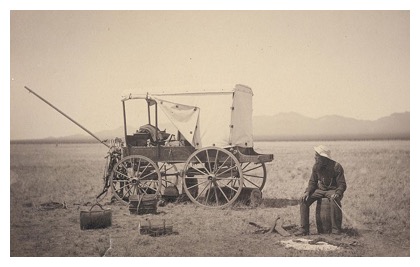 Pringlei – Named for Cyrus G. (Guernsy) Pringle (1838-1911), an American botanist who catalogued North American plants, especially those of Mexico. He is especially noted for his prolific collections, making him among the top five plant collectors of all time, and for the sheer number of new species he discovered. Unfortunately, F. pringlei (B.L.Rob. & Seaton 1893) is now a synonym of F. thymifolia in ➤ Section Encliandra.
Pringlei – Named for Cyrus G. (Guernsy) Pringle (1838-1911), an American botanist who catalogued North American plants, especially those of Mexico. He is especially noted for his prolific collections, making him among the top five plant collectors of all time, and for the sheer number of new species he discovered. Unfortunately, F. pringlei (B.L.Rob. & Seaton 1893) is now a synonym of F. thymifolia in ➤ Section Encliandra.
(Illustration: Self portrait taken by Pringle while in the field in 1888. Note the blurred cord leading to the camera from his left hand. Grey Herbarium.)
 Pringsheim, Nathanael (1823-1894) – Pringsheim was a celebrated German botanist, considered one of the leaders of the great botanical renaissance of the 19th century, who made many important contributions, especially in the field of phycology. In 1858, he founded the Jahrbücher für wissenschaftliche Botanik, which he edited until his death. He was also founder and first president of the German Botanical Society in 1882. Astonishingly, Pringsheim carried out most of his research in his own private laboratory in Berlin and only held a university professorship at Jena from 1864-1868. See F. pringsheimii in ➤ Section Fuchsia.
Pringsheim, Nathanael (1823-1894) – Pringsheim was a celebrated German botanist, considered one of the leaders of the great botanical renaissance of the 19th century, who made many important contributions, especially in the field of phycology. In 1858, he founded the Jahrbücher für wissenschaftliche Botanik, which he edited until his death. He was also founder and first president of the German Botanical Society in 1882. Astonishingly, Pringsheim carried out most of his research in his own private laboratory in Berlin and only held a university professorship at Jena from 1864-1868. See F. pringsheimii in ➤ Section Fuchsia.
Pringsheimii – Named by Ignaz Urban in honor of Nathanael Pringsheim (1823-1894). The original collection was made by Henrik [Heinrich] Baron von Eggers (1844–1903), a Danish military officer posted to the Danish Antilles (US Virgin Islands since 1917) who became a botanist after his retirement. Eggers botanized extensively in the Caribbean and was in Santo Domingo in 1887 (Eggers No. 2159). Symb. Antill. 1: 375 1899. See ➤ Pringsheim directly above; and F. pringsheimii Urb. in ➤ Section Fuchsia.
Procumbens – Lying along the ground. See F. procumbens in ➤ Section Procumbentes.
Prostrata – Prostrate. F. prostrata (Baill. 1880) is a synonym of F. procumbens in ➤ Section Procumbentes.
Proximal – Close to the point of attachment or origin. For example, the proximal end of a branch. See also ➤ Distal.
Pubescens – Covered with short, downy hairs. F. pubescens (Cambess. 1830) is a synonym of F. regia subsp. reitzii in ➤ Section Quelusia, See also F. rivularis subsp. pubescens in ➤ Section Fuchsia, which is one of two subspecies.
Pulchella – Pretty. F. pulchella (Woodson & Seibert 1937) is a synonym of F. microphylla subsp. hemsleyana in ➤ Section Encliandra.
Pumila – Small. dwarf. F. pumila (Voss) Voss 1894) and F. pumila (Meun. 1926) are both synonyms of F. magellanica in ➤ Section Quelusia.
Putumayensis – From the Putumayo Department in Colombia. See F. putumayensis in ➤ Section Fuchsia.
 Pyramid – A specimen fuchsia that has been trained into a tall shape with a wider base tapered to a point. To form the pyramid, an upright stem is first selected and grown to about two feet. The tip is then removed and side shots are allowed to develop. These are stopped at two or three sets or leaves. The top shoot, however, is grown on for another two feet before it's stopped, along again with the previously stopped side shoots on the lower level. The process is repeated until the desired height and base width are reached. It will usually take two years to create a large-sized specimen. Such large pyramids were a particular favorite during the Victorian period and their appearance was a testament to the resources of many estate or public gardens (as evidenced by the costly heated greenhouses necessary to grow them on slowly over the winter) and the abilities of their gardeners. The loss of staff and changed economics of the First World War effectively ended their production on any scale. A similar shape, the cone, is considered to be narrower at the base. ➤ Biennial Method.
Pyramid – A specimen fuchsia that has been trained into a tall shape with a wider base tapered to a point. To form the pyramid, an upright stem is first selected and grown to about two feet. The tip is then removed and side shots are allowed to develop. These are stopped at two or three sets or leaves. The top shoot, however, is grown on for another two feet before it's stopped, along again with the previously stopped side shoots on the lower level. The process is repeated until the desired height and base width are reached. It will usually take two years to create a large-sized specimen. Such large pyramids were a particular favorite during the Victorian period and their appearance was a testament to the resources of many estate or public gardens (as evidenced by the costly heated greenhouses necessary to grow them on slowly over the winter) and the abilities of their gardeners. The loss of staff and changed economics of the First World War effectively ended their production on any scale. A similar shape, the cone, is considered to be narrower at the base. ➤ Biennial Method.
(Illustration: George Bright standing among his fuchsia pyramids in an undated photograph, probably from the early 1900s. Bright was the son-in-law of the legendary fuchsia breeder and grower, ➤ James Lye. Not much is known about him but he continued his father-in-law's legacy of large fuchsia pyramids for a number of years after his death.)
Pyrifolia – Having leaves leaves like a Pyrus, or pear. F. pyrifolia (C. Presl. 1834) is a synonym of F. regia in ➤ Section Quelusia.
Quaternate – Arranged in sets of four.
Quelusia – Named for Queluz Palace, the summer residence of the former Kings of Portugal, located in Queluz near Lisbon. Domenico Vandelli, first applied Quelusia to a Brazilian fuchsia, listed without a specific epithet but probably F. coccinea, provided by Joaquim Veloso de Miranda. José Mariano de Conceição Veloso also used Quelusia regia in his Florae Fluminensis (1825–27). The name was synonymized with Fuchsias but revived by the Swiss botanist Augustin Pyramus de Candolle (1778 -1841) for the Quelusia section of the genus in 1828. See ➤ Section Quelusia.
Quercetorum – From oak forests. See F. microphylla ssp. quercetorum in ➤ Section Encliandra.
Quinduensis – From Quindio, Colombia. Grammatically, this species epithet should have been more properly rendered as "quindiuensis" when originally described. F. quinduensis (Kunth 1823) is a synonym of F. petiolaris in ➤ Section Fuchsia.
Pallescens – Palid or pale; becoming palid or pale. See F. pallescens in ➤ Section Fuchsia.
Palo Blanco – Common name occasionally recorded in Chile for F. magellanica. Chilco, however, is more usual.
Palo de Yegua – Common name in Chile for F. lycioides. Also sometimes called palo falso. However, the name Palo de yegua is also applied to another unrelated Chilean native, Senecio yegua (Acrisione denticulata), the palpalén.
Palynology – The study of dust and other minute particles. The discipline includes the study of both modern and fossilized grains of Fuchsia pollen. See ➤ Diporites aspis.

(Illustration: Fuchsia 'First Success'.)

(Illustration: A blossoming panicle on F. paniculata; See also the illustration under ➤ Berries for the same species in full fruit.)
Paniculata – Flowers held in panicles. See F. paniculata in ➤ Section Schufia of which there are two subspecies. Because both bear flowers in similar lilac-like panicles, F. paniculata is often confused with its close relative, F. arborescens. However, it generally forms a smaller shrub growing only roughly to half the size of the later. Its more variably shaped leaves are also generally smaller, with a ridged surface and distinctively minutely to coarsely serrated margins. F. arborescens, on the other hand, generally forms a larger shrub or small tree with smoother and more consistently shaped, oblanceolate leaves that have an entire margin. There are also other tell-tale differences in the flowers as well. The unopened buds of F. paniculata, for example, are comparatively more long and narrow than those of F. arborescens, which are broader and more blunted towards the tip. See also Arborescens.
Páramo – A variety of similar neotropical alpine ecosystems found above the continuous forest line but below the permanent snow line and characterized by a vegetation dominated by grasses, shrubs and giant rosette-forming plants. While some scientists use the term broadly, páramo most particularly refers to those high altitude ecosystems located in the northern Andes of South America, specifically in Venezuela, Colombia, Ecuador and Peru, and some adjacent areas of southern Central America. The classification can be further broken down into the superpáramo and subpáramo.
The superpáramo generally occurs between 4,500 to 4,800 meters in altitude and is a transitional zone with the lowest temperatures, precipitation and poorest soils.
The subpáramo is a lower and more diverse transitional zone. It generally occurs between 3,000 to 3,500 meters in altitude and combines the characteristics of both the grass-dominated páramo above and the forest below, containing small, scattered trees, or even pockets of forest in sheltered microclimates.
See also Campos de Altitude.
(Illustration: Páramo in the Sumapaz National Park in Colombia, photo by ➤ Yuri Romero Picon, Wikipedia, 2008.)
Parviflora – Having small flowers. F. parviflora (Lindl.1827) is an accepted species. F. cylindracea (Lindl. 1838) is a synonym of this species while F. parviflora (Zucc. 1837) is a synonym of F. encliandra subsp. encliandra (Steudel 1840).

Pavón, along with the French physician and botanist Joseph Dombey (until 1784), had been selected to assist Hipólito Ruiz on this major scientific exploration of Spanish possessions in the Americas commissioned by the reformist Spanish king, Charles III.
The expedition was a major success and returned to the Royal Botanical Garden in Madrid in 1788 with more than ten thousand engravings, 2,254 botanical drawings with descriptions and numerous other materials. Ruiz, along with Pavón, would publish the results in a number of volumes.
A member of the Royal Academy of Medicine in Madrid, Pavón would also be inducted into the Linnaean Society in London in 1820.
See also ➤ Ruiz; Ruiz & Pavón; ➤ Royal Botanicial Expedition to the Viceroyalty of Peru.

(Illustrations: 1. Cinchona hirsuta (Ruiz & Pavon 1799), Flora Peruviana, et Chilensis, Plates 153-325, Vol. 2, Tab. 192 (1798-1802). Of intense interest in Europe at the time was the pharmacology of New World plants, especially important ones such as Cinchona, the source of the invaluable anti-malarial drug, quinine; 2. Autograph label from a specimen collection of Cinchona apparently made by Pavón at "los Azogues de Loxa" (Loja; Azogues is today in Ecuador's Cañar Province) during the expedition.)
Pedicel – The stalk of individual flower; a stalk bearing a single flower within a cluster (see also ➤ Peduncle).
Peduncle – The axis of an inflorescence; the stalk supporting an inflorescence; the short stalk at the base of a leaf or reproductive structure (see also pedicle).
Pelargoniums – See Geraniums.
Pendientes de la Reina – Common name for the fuchsia in some Spanish-speaking areas. Literally "Queen's Eardrops." There is often an association with the Virgin Mary, as the Queen of Heaven, and the form, Pendientes de la Virgen, is sometimes found. See also ➤ Aljaba, ➤ Chilco, ➤ Corales, ➤ Coralitos.
Pendula – Pendant, hanging. F. pendula (Salisb. 1796) is a synonym of F. coccinea in ➤ Section Fuchsia.
Penduliflora – With pendant or hanging flowers. F. x peduliflora (Hook.f 1877) is an unresolved name.
Pendulina – Pendulous, hanging. F. x pendulina (Veitch 1856) is an unresolved name.
Perbrevis – Very small or little. F. perbrevis (I.M.Johnston 1925) is a synonym of F. verrucosa ➤ Section Verrucosa.
Perfect Flowers – Bisexual flowers on which both the male and female reproductive parts are contained within the same flower. See also ➤ Breeding Systems.
Perianth – The outermost part of a flower consisting of the calyx and corolla together.
Perscandens – Scrambling. See F. perscandens in ➤ Section Skinnera.
Personal Names – See ➤ Fuchsia (personal name).
Pests & Diseases – See ➤ Aphids, ➤ Caspid Bug, ➤ Fuchsia Gall Mite, ➤ Fuchsia Rust, ➤ Red Spider Mite, ➤ Vine Weevil, ➤ Whitefly.
Petal – A single part of the corolla. Fuchsia blossoms naturally have four petals in the corolla. (See also ➤ Double, ➤ Semi-double, ➤ Single.)
Petaloid – Smaller outer petals of the corolla.
Petiolaris – Having a remarkable leaf stalk. See F. petiolaris in ➤ Section Fuchsia.
Petiole – The leaf stalk.
Phenotype – The appearance of a plant as influenced by the environment on its genotype, or inherited genetic code. In its simplest terms, there is often a distinct difference in flower and leaf color and size, for example, when the same fuchsia hybrid is grown in a bright or sunny exposure as opposed to a more shady one. Another example might be species that are naturally liana-like or vine-like, such a Fuchsia regia, when scrambling through, over, or into brush and trees, but will grow more compact, upright and shrub-like when exposed.
Photosynthesis – The chemical process by which plants convert carbon dioxide and water into stored energy in the form of sugar molecules using energy from sunlight. Oxygen molecules are released as a by-product. This process take place primarily in ➤ chloroplasts, located in a plant's leaves, using chlorphyll (see also).
Phylogenetics – In Botany, the study of evolutionary relationships among groups of plants.
Pilaloensis – From Pilaló in Cotopaxi Province in Ecuador. See F. pilaloensis in ➤ Section Hemsleyella.
Pilosa – Covered in soft, fine hairs. See F. pilosa in ➤ Section Fuchsia.
Pilose – Covered with soft, fine hairs. Some fuchsias, such as F. alpestris or F. bracelinae, have leaves and stems that can be very densely pilose especially in young growth. Since the more pilose fuchsia species have not been commonly used for crosses, this trait is not usually seen in any garden cultivars.
Pinching – Also called stopping. The removal of the growing tip of a branch. Pinching or stopping will encourage side buds to break from the leaf axils and result in a bushier, more floriferous plant. A plant will often be pinched or stopped several times before it's left to flower for the season.
Pistil – The female division of the flower which consists of the ovary, stigma and style.
Pistillate Flowers – Female flowers in which the male reproductive parts are absent or reduced to sterility. See also ➤ Breeding Systems.
Pitz'otz' – Fuchsia encliandra subsp. tetradactyla and Fuchsia thymifolia subsp. minimiflora in Tzotzil, a language of the Maya in the state of Chiapas, Mexico. The name is also extended to Cuphea cyanea, Ludwigia octovalvis and Monnica xalapensis. See ➤ Maya.
Plant Geography– The spatial distribution of plants and vegetation in different environment and regions. Also termed phytogeography, phytochorology, geobotany, geographical botany, or vegetation science.
The Plant List – An on-line project undertaken by the Royal Botanic Gardens, Kew and the Missouri Botanical Garden, St. Louis, with other collaborators worldwide, that combines several institutional checklists to create a working list of all known plant species.
The first Version 1.0 released in December 2010 aimed to be comprehensive for species of Vascular plant (flowering plants, conifers, ferns and their allies) and for Bryophytes (mosses and liverworts). while it does not currently include algae or fungi, Version 1.1 (September 2013) does have 1,293,685 million scientific plant names. 350, 699 are accepted species names and the rest are synonyms. No vernacular or common plant names are included.
You can find most all current accepted and synonymous species within Fuchsia at ➤ The Fuchsia Plant List. However, as with any undertaking of this amazing immensity, omissions can creep in and about 23% of the names in the full list are still unresolved. Fuchsia paniculata subsp. paniculata, for example, is listed as a synonym as of this writing in Version 1.1. That’s incorrect. Fuchsia paniculata subsp. mixenesis is also missing. Both have been validly described since 1998.
Frustratingly in this Age of Information, the Plant List’s data waits for system wide version updates rather than faster more immediate data set corrections. Inaccuracies linger years longer than they should.
Plant Patent – The abbreviation PPAF (Plant Patent applied For) will sometimes be seen on commercially raised plants in the United States and indicates an application for a plant patent from the U.S. Patent and Trademark Office that "precludes others from asexually reproducing or selling or using the patented plant. A plant patent expires 20 years from the filing date of the patent application." Plants for which patents have already been granted will have a patent number in the format "PP# 00,000" on the label. Plants become public domain when the patent expires.
Platypetala – Broad-petalled. F. platypetala (I.M Johnston 1939) is an unresolved name.

Almost nothing is known about Plumier's family and early life except that he was born in Marseille and entered the religious order of the Minims there at the age of sixteen. He devoted himself to scientific studies with the Minims, studied botany for a period in Italy, and eventually returned to France to became a pupil of Joseph Pitton de Tournefort (1656-1708), the noted botanist and professor at the Jardin du Roi in Paris, whom he accompanied on botanical explorations. Plumier's botanical connections, and his meticulous collections and observations along the coasts of Provence and the Languedoc, of course brought him to the attention of fellow scientists, as well as the royal government in Paris.

Plumier was then sent back to the Antilles on a second journey in 1693, and on yet a third in 1695, assisted there by the Dominican botanist and missionary Jean-Baptiste Labat (1663-1738). The materials he gathered were prodigious and only partially released in his Nova Plantarum Americanum Genera (Paris, 1703). It was in this work, though, that Plumier first described Fuchsia triphylla, flore coccineo, found growing on Hispaniola during the course of the third expedition in about 1696–97. He baptized the new genus in honor of the celebrated German physician and botanist, Leonhart Fuchs (see also).

It's interesting to think what such an accomplished and meticulous botanist as Plumier might have discovered in Peru, earlier rather than later, had he lived to make the journey. The Monastery of the Victory was secularized in in the eighteenth century and the once-beautiful complex was much reduced and damaged, especially as it was used as a prison from 1886 until 1981. Today it's partially restored and preserved as an historic Bien de Interés Cultural and the celebrated royal botanist's body presumably still lies somewhere within the monastery's former perimeter, buried in a grave unmarked and forgotten.

Herman Boerhaave (1668–1738), a celebrated professor of botany and medicine at the University of Leiden in the Netherlands, had 508 of Plumier's drawings copied for him. They were later published in Plumier's honor by Johannes Burman (1707–1780), an professor of botany in Amsterdam who had studied under Boerhaave and even employed a young Carl Linnaeus (1707–1778) to complete a flora of Ceylon for him during his stay there in 1735, as the Plantarum americanarum, quas olim Carolus Plumerius botanicorum princeps detexit in 1755–1760. Linnaeus would use the drawings in this volume to accept Plumier's Fuchsia triphylla into the sixth edition of his Genera Plantarum.


While he honored a number of people in the names of many now well-known genera, such the Begonia, Bromelia, Fuchsia, Gesnera, Lobelia, Lonicera, Magnolia and Pittonia—even a Suriana—Plumier rightfully and modestly never named one of his discoveries for himself. Joseph Pitton de Tournefort, the recipient of Pittonia and his former teacher and fellow botanist, would see to that honor with the Plumeria, the frangipani as it's also commonly known, in 1700. Plumeria was later accepted by Linneus in 1753.
(Illustrations: 1. Portrait of Plumier (Nova Plantarum, 1704); 2. F. triphylla illustrated on Plate 14 in Nova Plantarum. 3. View across Cadiz's harbor towards the Puerto de Santa María where Plumier died in 1704 (Basset, Paris, 1700); 4. Plate of Fuchsia from Burman's Plantarum americanarum, quas olim Carolus Plumerius botanicorum princeps detexit in (1755–1760). It shares the page with Gesneria; 5. Plate from Plumier’s L’Art de Tourner, ou de Faire en Perfection toutes Sortes d'Ouvrages au Tour, 1706; 6. Plumeria, named by Joseph Pitton de Tournefort to honor Plumier. Institutiones rei herbariæ, vol. 3: t. 439, 1700.)
Pollen – The powdery substance produced in the fuchsia's anthers. Pollen contains the male reproductive cells, male gametes or sperm cells. Fertilization results when pollen cells are carried to the stigmas of other flowers by wind or insects, or by the intentional hand of the hybridizer, and germinate to transfer the sperm to the ovule via a pollen tube. Pollen of the Onagraceae family, of which Fuchsia is a member, is easily differentiated from that of most other angiosperm families under the microscope by tetrads and the presence of sticky viscin threads that makes it conspicuously clumped. (See Tetrads, Viscine Threads)
Pollen Fossils – In palynology, the study of dust and other minute particles including spores and pollen, taxonomic distinctions are usually kept between fossil and modern pollen forms unless there is ample scientific evidence to support a connection between the two. Fossil pollen similar to that of modern Fuchsia, for example, was originally described as Diporites aspis Pocknal & Mildenhall. More fossil pollen discoveries were closely examined. A study done in 1985, compared them with similar modern forms and revealed that Diporities aspis and Fuchsia were the same. Later, an unique fossil Fuchsia flower and an associated anther mass with in situ pollen from the early Miocene were discovered in a quarry in New Zealand, unequivocally showing that Diportites apsis belongs to the genus Fuchsia. An identification blow the genus level, however, remains impossible to make. The replacement name for Diporites aspis is Koninidites aspis (Pocknall & Mildenh.) See Fuchsia antiqua.
Pollenizer – The plant that is a source of pollen in the pollination process. In stating the parentage of crosses, such as F. magellanica 'Molinae' x F. excorticata for 'Whiteknight's Amethyst', the plant listed first is the female parent followed secondly by the pollenizer. The term shouldn't be confused with a pollinator (see also).
(Illustration: A bee pollinates Fuchsia magellanica in the Patagonian Lake District, Argentina.)

Pollinization – The process by which pollen is transferred from the anthers to the surface of the stigma enabling fertilization and sexual reproduction in plants
Polyantha – Having many flowers. See F. polyantha (Killip ex Munz 1943) in ➤ Section Fuchsia.
Polyanthella – F. polyanthella (I.M. Johnston 1925) is a synonym of F. ovalis in ➤ Section Fuchsia.
Polyploid, Polyploidy – Having multiple sets of chromosomes.

Porcher, Pierre-Félix (1797-1878) – Félix Porcher was president and co-founder of the Société d'Horticulture d'Orléans in France. His article on fuchsias, which had first appeared in the Society's Bulletin, was published as the first book on Fuchsias, Le Fuchsia, son histoire et sa culture, in 1844 and listed three hundred fuchsias. A second edition, released in 1848, was substantially expanded to list well over five hundred. Porcher published four books on fuchsias in all, the last one in 1874.
Pot bound – The condition where a plant's roots have filled all the available space of the soil in a pot. Some plants are maintained in this condition to induce flowering or dwarfing for bonsai. Vigorously performing plants such as fuchsias, however, will benefit from potting on, or top and root pruning into fresh soil, to maintain their strength and flowering.
Pot on – To place a plant into larger pot to keep it growing. It's usually best to pot on in small increments to avoid empty soil from becoming water-logged and stagnant before a plant's roots can reach into it.
Pot up – To pot new cuttings for the first time.
Propagation – Increasing plants by seed or cuttings. Most garden fuchsias are complex hybrids that won't come true from seed so need to be increased through cuttings to maintain their desirable characteristics.

(Illustration: Self portrait taken by Pringle while in the field in 1888. Note the blurred cord leading to the camera from his left hand. Grey Herbarium.)

Pringsheimii – Named by Ignaz Urban in honor of Nathanael Pringsheim (1823-1894). The original collection was made by Henrik [Heinrich] Baron von Eggers (1844–1903), a Danish military officer posted to the Danish Antilles (US Virgin Islands since 1917) who became a botanist after his retirement. Eggers botanized extensively in the Caribbean and was in Santo Domingo in 1887 (Eggers No. 2159). Symb. Antill. 1: 375 1899. See ➤ Pringsheim directly above; and F. pringsheimii Urb. in ➤ Section Fuchsia.
Procumbens – Lying along the ground. See F. procumbens in ➤ Section Procumbentes.
Prostrata – Prostrate. F. prostrata (Baill. 1880) is a synonym of F. procumbens in ➤ Section Procumbentes.
Proximal – Close to the point of attachment or origin. For example, the proximal end of a branch. See also ➤ Distal.
Pubescens – Covered with short, downy hairs. F. pubescens (Cambess. 1830) is a synonym of F. regia subsp. reitzii in ➤ Section Quelusia, See also F. rivularis subsp. pubescens in ➤ Section Fuchsia, which is one of two subspecies.
Pulchella – Pretty. F. pulchella (Woodson & Seibert 1937) is a synonym of F. microphylla subsp. hemsleyana in ➤ Section Encliandra.
Pumila – Small. dwarf. F. pumila (Voss) Voss 1894) and F. pumila (Meun. 1926) are both synonyms of F. magellanica in ➤ Section Quelusia.
Putumayensis – From the Putumayo Department in Colombia. See F. putumayensis in ➤ Section Fuchsia.

(Illustration: George Bright standing among his fuchsia pyramids in an undated photograph, probably from the early 1900s. Bright was the son-in-law of the legendary fuchsia breeder and grower, ➤ James Lye. Not much is known about him but he continued his father-in-law's legacy of large fuchsia pyramids for a number of years after his death.)
Pyrifolia – Having leaves leaves like a Pyrus, or pear. F. pyrifolia (C. Presl. 1834) is a synonym of F. regia in ➤ Section Quelusia.
Quaternate – Arranged in sets of four.
Quelusia – Named for Queluz Palace, the summer residence of the former Kings of Portugal, located in Queluz near Lisbon. Domenico Vandelli, first applied Quelusia to a Brazilian fuchsia, listed without a specific epithet but probably F. coccinea, provided by Joaquim Veloso de Miranda. José Mariano de Conceição Veloso also used Quelusia regia in his Florae Fluminensis (1825–27). The name was synonymized with Fuchsias but revived by the Swiss botanist Augustin Pyramus de Candolle (1778 -1841) for the Quelusia section of the genus in 1828. See ➤ Section Quelusia.
Quercetorum – From oak forests. See F. microphylla ssp. quercetorum in ➤ Section Encliandra.
Quinduensis – From Quindio, Colombia. Grammatically, this species epithet should have been more properly rendered as "quindiuensis" when originally described. F. quinduensis (Kunth 1823) is a synonym of F. petiolaris in ➤ Section Fuchsia.
